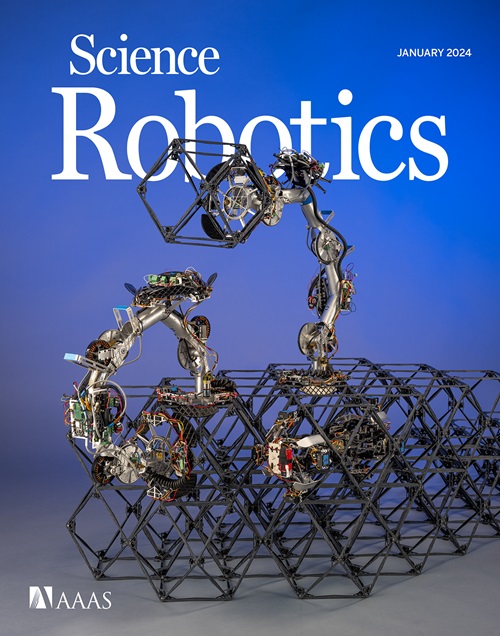多功能膝关节外骨骼可减轻抬举、降低和搬运任务中的股四头肌疲劳
IF 26.1
1区 计算机科学
Q1 ROBOTICS
引用次数: 0
摘要
股四头肌在重复性举起、放下和搬运(LLC)过程中特别容易疲劳,从而影响工人的工作表现和姿势,最终导致下背部受伤的风险。虽然机器人外骨骼已针对抬起-放下等特定使用情况进行了开发和优化,但其控制器缺乏针对许多疲劳任务中关键肌肉的多功能性或可定制性。在这里,我们介绍了一种任务自适应膝关节外骨骼控制器,它能自动调节虚拟弹簧、阻尼器以及重力和惯性补偿,以辅助下蹲、平地行走以及斜坡和楼梯的上/下坡。与端到端神经网络不同的是,该控制器由可预测、有边界的组件组成,具有可解释的参数,可进行数据驱动的优化,以实现仿生辅助和后续特定应用的调整,例如,在多地形有限责任公司(Multiterrain LLC)中最大化股四头肌辅助。在可背负式膝关节外骨骼上部署辅助力矩后,10 名人类用户在多地形 LLC 任务中的股四头肌辅助力矩全面减少(除平地行走外效果显著),无需针对特定用户进行校准。外骨骼还明显改善了在重复性举起放下过程中因疲劳而导致的基于时间的性能和姿势缺陷。最后,该系统促进了任务的无缝转换,并在多地形回路中获得了较高的疲劳后有效性评级。这些研究结果表明,这种多功能控制框架可以在多个任务中针对关键肌肉进行控制,特别是减轻股四头肌疲劳及其有害影响。本文章由计算机程序翻译,如有差异,请以英文原文为准。
A versatile knee exoskeleton mitigates quadriceps fatigue in lifting, lowering, and carrying tasks
The quadriceps are particularly susceptible to fatigue during repetitive lifting, lowering, and carrying (LLC), affecting worker performance, posture, and ultimately lower-back injury risk. Although robotic exoskeletons have been developed and optimized for specific use cases like lifting-lowering, their controllers lack the versatility or customizability to target critical muscles across many fatiguing tasks. Here, we present a task-adaptive knee exoskeleton controller that automatically modulates virtual springs, dampers, and gravity and inertia compensation to assist squatting, level walking, and ramp and stairs ascent/descent. Unlike end-to-end neural networks, the controller is composed of predictable, bounded components with interpretable parameters that are amenable to data-driven optimization for biomimetic assistance and subsequent application-specific tuning, for example, maximizing quadriceps assistance over multiterrain LLC. When deployed on a backdrivable knee exoskeleton, the assistance torques holistically reduced quadriceps effort across multiterrain LLC tasks (significantly except for level walking) in 10 human users without user-specific calibration. The exoskeleton also significantly improved fatigue-induced deficits in time-based performance and posture during repetitive lifting-lowering. Last, the system facilitated seamless task transitions and garnered a high effectiveness rating postfatigue over a multiterrain circuit. These findings indicate that this versatile control framework can target critical muscles across multiple tasks, specifically mitigating quadriceps fatigue and its deleterious effects.
求助全文
通过发布文献求助,成功后即可免费获取论文全文。
去求助
来源期刊

Science Robotics
Mathematics-Control and Optimization
CiteScore
30.60
自引率
2.80%
发文量
83
期刊介绍:
Science Robotics publishes original, peer-reviewed, science- or engineering-based research articles that advance the field of robotics. The journal also features editor-commissioned Reviews. An international team of academic editors holds Science Robotics articles to the same high-quality standard that is the hallmark of the Science family of journals.
Sub-topics include: actuators, advanced materials, artificial Intelligence, autonomous vehicles, bio-inspired design, exoskeletons, fabrication, field robotics, human-robot interaction, humanoids, industrial robotics, kinematics, machine learning, material science, medical technology, motion planning and control, micro- and nano-robotics, multi-robot control, sensors, service robotics, social and ethical issues, soft robotics, and space, planetary and undersea exploration.
 求助内容:
求助内容: 应助结果提醒方式:
应助结果提醒方式:


